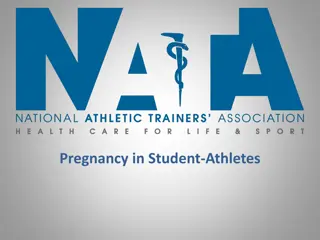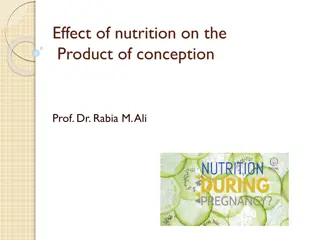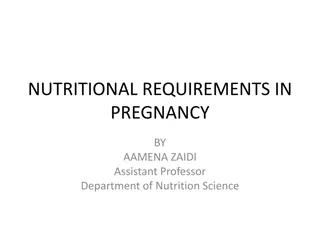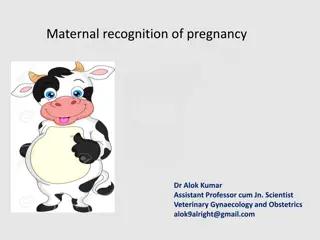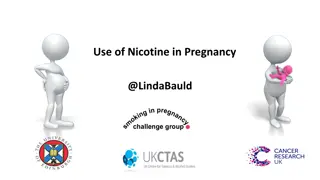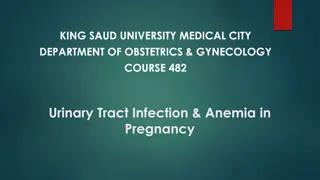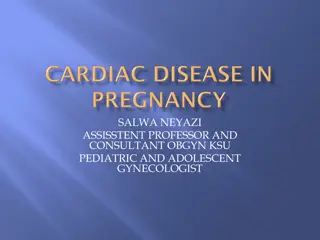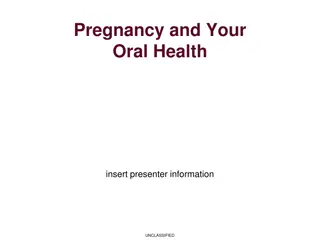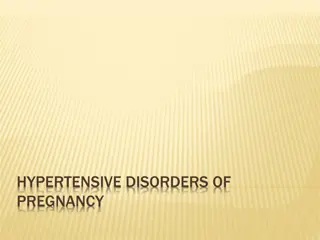Understanding the Impact of Drugs on Pregnancy Development
This lecture covers factors influencing placental transfer, harmful effects of drugs at different developmental stages, FDA classifications of drugs, and teratogenic drugs. It explains how drugs cross the placenta, including physiochemical properties and stage of development affecting transfer. The content emphasizes the risks of drug use during pregnancy and highlights the critical stages of blastocyst formation, organogenesis, and histogenesis in fetal development.
Download Presentation

Please find below an Image/Link to download the presentation.
The content on the website is provided AS IS for your information and personal use only. It may not be sold, licensed, or shared on other websites without obtaining consent from the author. Download presentation by click this link. If you encounter any issues during the download, it is possible that the publisher has removed the file from their server.
E N D
Presentation Transcript
Editing File Editing File Mnemonic File Mnemonic File Reproduction Block Pharmacology team 438 Teratogens and Drugs of Abuse in Pregnancy Objectives: By the end of the lecture , you should know: Factors affecting placental transfer Harmful effects of drugs during different stages of development FDA classifications of drugs Teratogenic Drugs Keep on vibin Adverse effects of drugs Drugs of abuse Color index: Black : Main content Red : Important Blue: Males slides only Purple: Females slides only Grey: Extra info or explanation Green : Dr. notes
Medications in Pregnancy Majority of women are exposed to medications during pregnancy Unless necessary, drugs should not be used in pregnancy because many can harm the fetus Half of the drugs have unknown effect on the fetus About 2-3% of all birth defects are a result of the use of drugs How do drugs cross the placenta? 1 Most drugs can cross the placenta by passive diffusion 2 Placental membrane is semi-permeable 3 Movement of drugs through the placenta is limited by a single layer of trophoblasts Factors controlling placental drug transfer Physiochemical properties Stage of development Duration of exposure 1- Physiochemical Properties of the Drug Lipid solubility and Ionization Lipid soluble drugs diffuse readily across the placenta and enter fetal circulation1 Example: Thiopental crosses placenta and causes sedation and apnea in infants Ionized drugs cross the placenta slowly leading to very low concentration in fetus Example: Succinylcholineand Pancuronium (skeletal muscle relaxants). - - Molecular Size MW of 250-500 cross the placenta easily 2 MW of 500-1000 crosses the placenta more difficulty MW >1000 can NOT cross the placenta Example: Heparin Protein Binding Protein binding in the maternal circulation hinders the passage of drugs3 Example: Propylthiouracil, Chloramphenicoland heparin - 1) lipid soluble drugs should not be used at all during pregnancy. Ionized drugs are preferable due to their slow rate of transfer. High molecular weight drugs are preferable during pregnancy. Because if the MW is high, the ability to cross the placenta is less. High protein binding drugs are preferable during pregnancy. 2) 3)
Factors controlling placental transfer 2- Stage of Placental and Fetal Development; they are 3 stages First Trimester Week 1-12 2nd & 3rd Trimesters Week 13 -28 Near Term Weeks 29-40 Blastocyst formation Week 1-2 1 Organogenesis Week 2 -8 Histogenesis and functional maturation Weeks 8 onwards Blastocyst Formation: Occurs from 1-16 days in the first trimester Period of dividing zygote and implantation(pre-differentiation) Drugs have all-or-nothing effect 1 Exposure to drugs during this period leads to prenatal death and abortion 2 Organogenesis: Occurs in 17-60 days in the first trimester Is the process where cells specializeto form tissues and organs It is the most sensitive2period of pregnancy Exposure to harmful drugs during this period leads to major birth defects or gross malformation (teratogenesis) 3 Histogenesis and Functional Maturation Growth and fetal development (maturation) occur at this stage (2nd and 3rd trimesters) Fetus depends on nutrients and hormonal supply Exposure to drugs during this period lead to functional problems, minor morphological abnormalities, growth retardation not gross malformations However, CNS is sensitive to toxic effects throughout pregnancy 4 Near term Occurs between 29th and 40th weeks Exposure to drugs lead to adverse effect on labor or neonates after delivery 1) If exposed to a harmful drug during this stage there are 2 possibilities: 1-The drugs is safe, nothing will happen and the pregnancy will continue normally. 2-Perinatal death and abortion. Avoid drugs during this stage. 1)
Teratogenesis It is the occurrence of congenital defects on the fetus What is a teratogen? Is any agent that may cause permanent birth defects by interfering in fetal development Examples: medications, street drugs, chemicals, diseases and environmental agents. Could be severeduring critical periods of development e.g. (organogenesis) - FDA Classification System Category Characteristics Examples Adequate and well-controlled human studies have failed to demonstrate a risk to fetus Drugs can be used in pregnancy Folic acid Thyroxine A No risk in animal studies No adequate and well-controlled human studies Drugs can be used in pregnancy Paracetamol Erythromycin B Adverse effects on the fetus in animals only No adequate and well-controlled studies in humans. Risk cannot be ruled out Drug may be used in serious situation despite its potential risk C Morphine Positive evidence of human fetal risk based on adverse reaction data from studies in humans, investigational or marketing experience May be used in serious diseases or life threatening situations Used in cases were benefits outweigh risks D Antiepileptics Proven fetal abnormalities in animal and human studies The risks involved in the use of the drug in pregnant women clearly outweigh potential benefits. Drugs are teratogens and contraindicated in pregnant womenor planning to conceive. Thalidomide (sedative) X Proven Teratogens (Category X) Anticonvulsants Valproic acid, phenytoin & carbamazepine Anticoagulant (warfarin) Antibiotics (tetracyclines, quinolone) 9. ACEIs 10. Ionizing radiation (diagnostic x-ray\radiating therapy) 11. radioactive Iodine (I131) 12. Corticosteroids 13. Hormones 6. - 7. 8. 1. - - 1. 2. 3. 4. - - Retinoids Vitamin A (limit to 700 ug/day) Isotretinoin (used to treat acne)1 Thalidomide (hypnotic) Lithium Alcohol Cytotoxic agents: Folate antagonists (methotrexate) Alkylating agents (cyclophosphamide) 1) If a patient completed her Isotretinoin treatment and is planning on getting pregnant, one year should elapse before getting pregnant.
Teratogenesis of Drugs (1st trimester) Teratogen Teratogenic Effect Phocomelia Thalidomide 1 The most notorious human teratogen Shortened or absent long bones of the limbs Absence of external ear Fetal Alcohol Syndrome Microcephaly Craniofacial abnormalities Intrauterine growth retardation CVS abnormalities CNS abnormalities Alcohol Fetal Hydantoin Syndrome Nail and digital hypoplasia Oral cleft (cleft lip and palate) Cardiac anomalies Mental and growth retardation Phenytoin Neural tube defect (spina bifida) Antiepileptic drug Impaired folate absorption 2 Valproic acid Altered growth of feet and bones Permanent teeth staining Enamel hypoplasia Tetracyclines3 Hypoplasia of nasal bridge CNS malformation Warfarin Corticosteroids Cleft lip and palate Ebstein s anomaly CVS anomalies mainly Valvular heart defect involving tricuspid valve Lithium Renal damage ACEIs disrupt fetal RAAS system which is essential for renal development Fetal & neonatal anuria Fetal hypotension Hypoperfusion Growth retardation - ACE inhibitors: Captopril Enalapril Hormones ( Cause serious genital malformation ) Testicular atrophy in male fetus Estrogens Fetal masculinization in female fetus Androgens Vaginal carcinoma of female offspring Diethylstilbestrol 1) 2) 3) Thalidomide was used for morning sickness in the past. Folic acid supplements should be prescribed if the pregnant female is on antiepileptics. Tetracyclines deposit in teeth and bones which causes the mentioned teratogenic effects.
Adverse Effects of Drugs (2nd & 3rd trimesters) During the 2nd and 3rd trimesters, some drugs can produce adverse effects on the fetus more likely than major malformations due to their pharmacological actions They affect growth and fetal development or may have toxic effects on fetal tissues Drug Adverse Effect Impaired teeth and bone development Yellow-brown discoloration of teeth Tetracyclines Ototoxicity (8th cranial nerve damage) Examples: Streptomycin and Kanamycin - Aminoglycosides Gray baby syndrome Chloramphenicol Adrenal atrophy Growth retardation Corticosteroids Bradycardia Neonatal hypoglycemia Placental insufficiency poor uterine blood flow fetal distress Propranolol And beta-blockers in general Risk for neonatal hypothyroidism and goiter Examples: Methimazole, Carbimazole, Iodide and Propylthiouracil - Antithyroids Prostaglandin synthesis inhibitors Constriction of ductus arteriosus Pulmonary Hypertension in newborns Increase in gestation time Prolong labor, neonatal bleeding Increase risk for postpartum hemorrhage Examples: Aspirin-indomethacin - NSAIDs Chronic use neonatal dependence and withdrawal symptoms Examples: Diazepam - Benzodiazepines Renal damage ACE inhibitors Risk of bleeding Warfarin Interference with suckling Respiratory depression Reduced blood flow Fetal distress Examples: Diazepam and morphine - CNS depressants Sulfonamides Displace bilirubin from albumin neonatal jaundice (kernicterus)
Drugs of Choice During Pregnancy Hypertension in Pregnancy Probably Safe Contraindicated -methyl dopa Labetalol Emergency ONLY: Hydralazine Labetalol ACE inhibitors Angiotensin II receptor blockers Thiazide diuretics Propranolol Ca2+channel blockers in mild HTN Coagulation Disorders in Pregnancy Probably Safe Contraindicated Heparin It is polar doesn t cross the placenta There s an antidote (protamine sulphate) Warfarin in all trimesters Cross the placenta 1st trimester: teratogenicity 2nd/3rd trimesters: risk of bleeding - - - - - Antibiotics in Pregnancy 1 Probably Safe Contraindicated Penicillins (ampicillin, amoxicillin) Cephalosporins Macrolides (erythromycin, azithromycin) As an alternative in penicillin-sensitive patients but erythromycin estolate should be avoided ( risk of hepatic injury to mother) Tetracyclines teeth and bones deformities Quinolones (ciprofloxacin) arthropathy (bone and cartilage damage) Aminoglycosides ototoxicity Sulfonamides neonatal jaundice and kernicterus Chloramphenicol Gray baby syndrome - Antithyroid Drugs in Pregnancy Are used in thyrotoxicosis or Grave s disease Propylthiouracil Methylthiouracil Carbimazole Radioactive iodine All can cross the placenta All have risk for congenital hypothyroidism and goiter The lowest dose of antithyroid drugs should be used Propylthiouracilis preferable over others2 Other Drugs Insulin is the best choice Avoid oral antidiabetics Antidiabetics Analgesics Acetaminophen is the best choice All antiepileptics have potential to cause malformations Avoid valproic acid because it s highly teratogenic Folic acid supplementations can prevent neural tube defects associated with antiepileptics Anticonvulsants 3 1) 2) 3) Rule: All antibiotics are contraindicated EXCEPT Beta lactams and Macrolides Has high protein binding ability Monotherapy is preferred during pregnancy.
Drugs of Abuse During Pregnancy What is a drug abuse? It is the habitual use of drugs not for therapeutic purposes but for alteration of one's mood or state of consciousness. The most commonly abused drugs are alcohol, barbiturates, benzodiazepines, opium alkaloids, amphetamines, cocaine, nicotine and marijuana Drug abuse may lead to organ damage, dependence, addiction and behavioral disturbance Abused Drug Description The use of Alcohol is contraindicated in all trimesters Chronic use of alcohol during early weeks of the 1st trimester leads to Fetal Alcohol Syndrome (FAS) which is characterized by: Microcephaly Low birth weight / Intrauterine growth retardation Craniofacial abnormalities CVS abnormalities CNS abnormalities Attention deficits Intellectual disability Mental retardation 1. 2. 3. 4. 5. - - - Alcohol Cocaine has low MW, so it can easily pass through the placenta It inhibits the reuptake of epinephrine, norepinephrine and dopamine causing: Vasoconstriction Rapid heart rate (tachycardia) Hypertension (vascular disruption) It decreases blood flow to uterus and fetal oxygenation (hypoxia) It increases uterine contractility 1. 2. 3. Cocaine Gross malformations include: Microcephaly Prematurity Growth retardation Low birth weight / Intrauterine growth retardation Mental retardation Placental abruption (early separation of the placenta from the uterus before delivery) Withdrawal symptoms 1. 2. 3. 4. 5. 6. 7. Tobacco contains nicotine and carbon monoxide which may harm the fetus. There is no evidence that it causes birth defects but it increases the risk of: Decreased blood flow to the placenta Fetal hypoxia Growth retardation Low birth weight Increased Spontaneous abortion Prematurity (preterm labor) Perinatal mortality (stillbirth) 1. 2. 3. 4. 5. 6. 7. Tobacco
Quiz MCQ Q1- A 19-year-old G1P0 woman lost her eyeglasses for a day. Constant squinting causes her to develop a headache, for which she takes ibuprofen. Which of the following poses the greatest risk to her fetus? A-Acute tubular necrosis B-Decreased pulmonary surfactant at birth C-Low birth weight D-Loss of physiologic heart shunt E-No risk ibuprofen is a safe drug for pregnancy Q2- A 33-year-old pregnant woman begins taking a new drug, Drug X, for morning sickness. Drug X has not been found to have adverse maternal or fetal effects in animal models, but no human studies have been done. Under which FDA Pregnancy Category would Drug X fall? A-Category A B-Category B C-Category C D-Category D E-Category X Q3- A 17-year-old pregnant woman asks her doctor what she can do about her acne. The doctor prescribes a topical benzoyl peroxide preparation, but the patient is unsatisfied with the results. She has a close friend taking isotretinoin for acne control, and her friend often tells her how well it works. She begins taking her friend s pills and is pleased with the reduction in her acne. In which FDA Pregnancy Category does this drug belong? A-Category A B-Category B C-Category C D-Category D E-Category X Q4- A 19-year-old woman is 24 weeks pregnant. She has received no prenatal care. She presents to the emergency department complaining of an intermittent headache and fatigue during her pregnancy. Her blood pressure has been at least 150/110 mm Hg. What is the most appropriate treatment of this patient? A-Hydralazine B- Propranolol C-Methyl dopa D-Prazosin E-Sodium nitroprusside Q5- A 26-year-old G2P1001 woman at 33 weeks gestation presents to the emergency department with pain and swelling in her right calf. On physical examination, Homans sign is positive. A duplex of the right calf confirms the presence of a deep vein thrombosis (DVT). What is the most appropriate treatment for the rest of her pregnancy? A-Streptokinase B-Aspirin C-Heparin D-Acetaminophen E-Warfarin Q6- A 23-year-old woman with lifelong epilepsy controlled with medication has just found out that she is pregnant. She has seizures once a month but seem to be controlled at present. Which of the following statements about epilepsy in pregnancy is true? A-Barbiturates should be considered B-Divalproex is considered a drug of choice C- Maintenance medication doses should be increased D-She should be taking high doses of folic acid E-She will likely have no change in seizure activity during pregnancy Q1 D; ibuprofen is a NSAID, which constricts the ductus arteriosus and cause pulmonary hypertension Q2 B; the study was done in animals but not humans Q3 E;isotretinoin is a well known teratogen during pregnancy Q4 A; Hydralazine is the drug of choice in hypertensive emergencies during pregnancy Answers: Q5 C; Heparin has a high MW and hugh polarity which prevents it from crossing the placenta Q6 D; antiepileptic impairs folic acid absorption and might cause a neural tube defect
Thank you for all the love and support you gave the team in those two years! Hope we made the context much easier to study. God bless you, Future doctors. Team Leaders: May Babaeer Zyad Aldosari This Amazing Work was Done By: Mohammed Alhuqbani Note writers Nouf AlShammari Quiz writers Mohammed Alhuqbani



